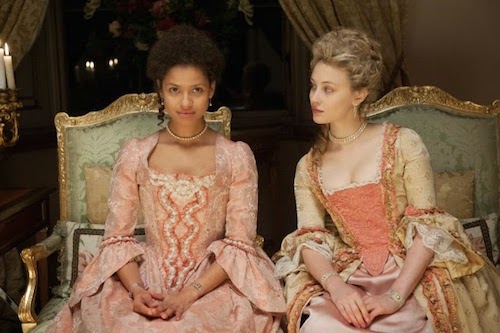Synopsis: Belle is inspired by the true story of Dido Elizabeth Belle (Gugu Mbatha-Raw), the illegitimate mixed race daughter of a Royal Navy Admiral. Raised by her aristocratic great-uncle Lord Mansfield (Tom Wilkinson) and his wife (Emily Watson), Belle’s lineage affords her certain privileges, yet the color of her skin prevents her from fully participating in the traditions of her social standing. Left to wonder if she will ever find love, Belle falls for an idealistic young vicar’s son bent on change who, with her help, shapes Lord Mansfield’s role as Lord Chief Justice to end slavery in England.
Release Date: May 16, 2014 MPAA Rating: PG-13
Genre(s): Drama, Period Piece
Film Review

Production
Set in England in the 18th century, Belle is the story of Dido Elizabeth Belle (Gugu Mbatha-Raw from Larry Crowne), a young woman who was born to an African slave woman who was impregnated by a British Navy Admiral. When her mother dies, she is taken in by her father (played by Stoker‘s Matthew Goode), but he is promptly sent out to sea and has to leave the girl with his aristocratic uncle, Lord Mansfield (Tom Wilkinson from The Grand Budapest Hotel), and his wife, Lady Mansfield (The Book Thief‘s Emily Watson). With the Mansfields, Dido grows up as a sister to their daughter, Elizabeth (Enemy‘s Sarah Gadon), but is still met with discrimination and scorn by family and strangers alike because of her skin color. Lord Mansfield, a judge who is presiding over a landmark case that will set a precedent as to whether slaves are people or property, enlists the help of a young law student named John Davinier (Sam Reid from Anonymous), who becomes smitten with Dido, and she with him. While Elizabeth is courted by suitors, Dido is confronted with the possibilities of her future as a half-black aristocrat. Dido juggles her feelings for John with the importance of his work with her Great Uncle.

The story for Belle was inspired by a painting, a work that is featured in the film and is thought to be the first piece of western art that shows a black subject as being on an equal eye level as a white subject. Many of the major events of the film, mostly those surrounding the legal cases, are real so, in typical Hollywood fashion, the movie gets slapped with the “based on a true story” label. Director Amma Asante (A Way of Life) captures the spirit of the time period fairly well, and even paints a pretty vivid picture of a girl struggling with her own identity, dealing with bigotry and discrimination both from her community and her own family. As a filmmaking exercise, it’s good. As a social or political statement, it’s not.
There’s something about Belle that just doesn’t work. For the heavy subject of racism and slavery, the film feels like it should have a lot more to say. The performances are good, even great in some cases. It’s competently shot, well edited, and the costumes and sets look great. It just seems too light and fluffy for the serious subject matter – it lacks any type of emotional impact or energy. It deals with the subject of prejudice and bigotry, but does so in a very safe way; there’s nothing in the film that disturbs or offends, even when half of the plot revolves around the drowning of an entire boat full of slaves. It’s like a Hallmark or Lifetime television movie, a ready-for-primetime historical drama that is more history than drama. There is no connection to the audience set up at any point. For example, when the characters are waiting for the big resolution of the legal battle, the audience should be ready to cheer if the outcome is positive, or jeer if it is negative. They aren’t. They’re just along for the ride, watching.

Writing
After some controversy that had to be settled with an official Writers Guild of America arbitration, the screenplay for Belle is credited to Misan Sagay (The Secret Laughter of Women), even though actors on set claimed to have only worked from a script that was written by director Amma Asante. True authorship aside, the story is more or less based on actual events; there really was a Dido Elizabeth Belle, and the case about the drowned slaves actually happened and was overseen by the Earl of Mansfield in 1783. The lack of known details about the life of the real Dido allowed Sagay (and Asante) to take liberties with the story, pumping up her involvement in the ruling on the case. So, as far as being a true story, the answer is “kind of…”
For entertainment purposes, Belle is a pretty stale script. There’s enough happening to keep an audience invested, but there’s disappointingly little emotional impact, even on the heavy issues of slavery and racism. The dialogue is dumbed-down as far as period pieces go, but that works to the film’s advantage; events are easy to follow, even when the plot gets needlessly complicated and cluttered. It’s all very safe and comfortable, and that’s the problem. There’s no edge or grit to it, nothing into which the audience can sink its teeth. It comes off as a G-Rated version of 12 Years a Slave, and that’s not exactly a compliment.
Cast and Crew
- Director(s): Amma Asante
- Producer(s):
- Screenwriter(s): Misan Sagay
- Story:
- Cast: Matthew Goode (Captain Sir John Lindsay)Emily Watson (Lady Mansfield)Tom Wilkinson (Lord Mansfield) Gugu Mbatha-Raw (Dido Elizabeth Belle)Miranda Richardson (Lady Ashoford)
- Editor(s): Victoria Boydell
- Cinematographer:
- Production Designer(s):
- Costume Designer:
- Casting Director(s):
- Music Score: Rachel Portman
- Music Performed By:
- Country Of Origin: USA